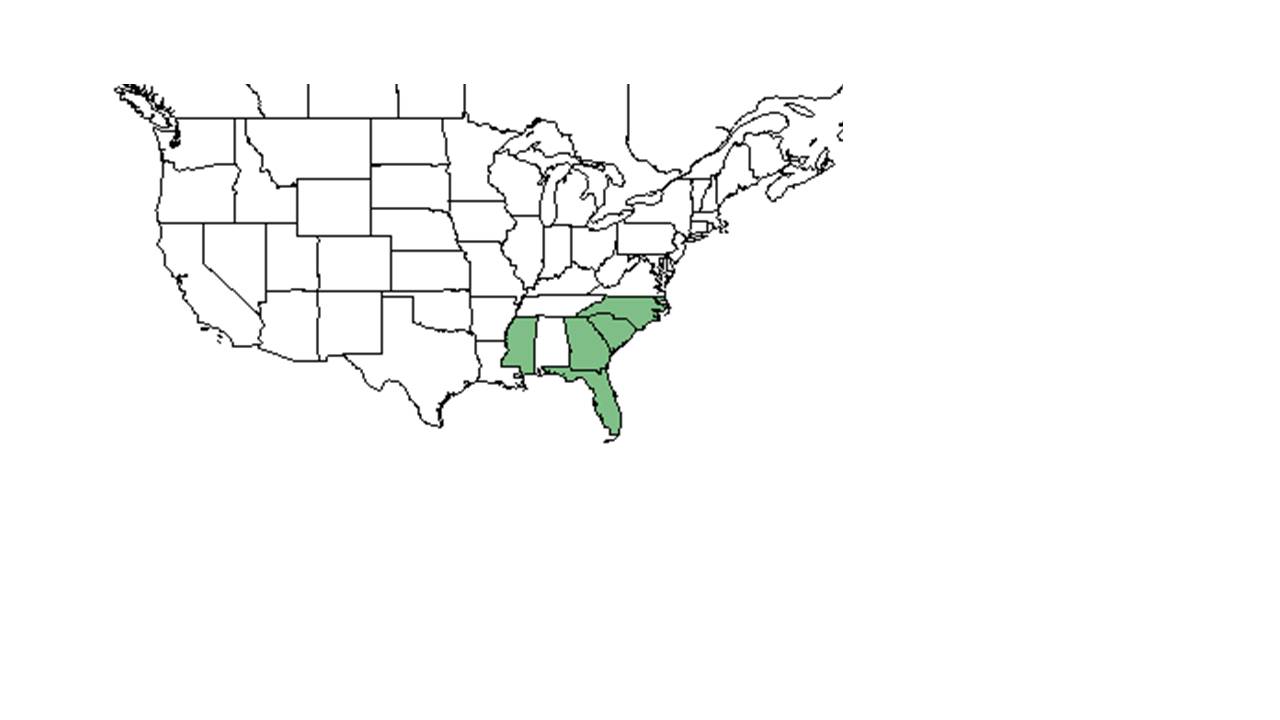Difference between revisions of "Andropogon longiberbis"
KatieMccoy (talk | contribs) |
|||
| Line 27: | Line 27: | ||
==Ecology== | ==Ecology== | ||
===Habitat===<!--Natural communities, human disturbed habitats, topography, hydrology, soils, light, fire regime requirements for removal of competition, etc.--> | ===Habitat===<!--Natural communities, human disturbed habitats, topography, hydrology, soils, light, fire regime requirements for removal of competition, etc.--> | ||
| − | + | Habitats of ''A. longiberbis'' include dry, well-drained, sandy soils of longleaf pine-turkey oak sandhills, limerock in pine flatwoods, dunes, wiregrass-palmetto flatwoods, sandy upland old fields, and sand pine-evergreen oak scrubs<ref name="fsu">Florida State University Robert K. Godfrey Herbarium database. URL: http://herbarium.bio.fsu.edu. Last accessed: June 2014. Collectors: W. P. Adams, L. C. Anderson, Wm. G. Atwater, R. Blaisdell, C. Campbell, A. F. Clewell, D. S. Correll, F. C. Creager, D. B. Creager, R. K. Godfrey, R. Kral, O. Lakela, W. Lindsey, R. E. Perdue Jr., C. R. Slaughter, and W. R. Stimson. States and Counties: Florida: Alachua, Brevard, Charlotte, Clay, Columbia, Dade, Duval, Franklin, Gilchrist, Hillsborough, Lafayette, Lee, Leon, Levy, Madison, Manatee, Marion, Nassau, Orange, Putnam, St. Johns, Suwannee, Taylor, and Wakulla.</ref><ref name="weakley">Weakley, Alan S. Flora of the Southern and Mid-Atlantic States: Working Draft of 21 May 2015. University of North Carolina Herbarium (NCU). PDF. 355.</ref>. It grows well in areas of sunlight and semi opened areas and can be found in disturbed habitats such as sandy vacant lots, roadsides, ditches, railroad banks, pine plantations, and waste grounds. | |
| − | Associated species include ''Pinus, Quercus'', wiregrass, palmetto, turkey oak, ''Phoebanthus, Psoralia, Schrankia, Smilax auriculata, Helianthemum'' sp., ''Cenchrus spinifex, Panicum'' spp. ''Heterotheca subaxillaris, Monarda punctata, Quercus hemispherica'', and others | + | Associated species include ''Pinus, Quercus'', wiregrass, palmetto, turkey oak, ''Phoebanthus, Psoralia, Schrankia, Smilax auriculata, Helianthemum'' sp., ''Cenchrus spinifex, Panicum'' spp. ''Heterotheca subaxillaris, Monarda punctata, Quercus hemispherica'', and others<ref name="fsu"/>. |
===Phenology===<!--Timing off flowering, fruiting, seed dispersal, and environmental triggers. Cite PanFlora website if appropriate: http://www.gilnelson.com/PanFlora/ --> | ===Phenology===<!--Timing off flowering, fruiting, seed dispersal, and environmental triggers. Cite PanFlora website if appropriate: http://www.gilnelson.com/PanFlora/ --> | ||
Revision as of 15:54, 29 March 2016
| Andropogon longiberbis | |
|---|---|
Error creating thumbnail: Unable to save thumbnail to destination
| |
| Scientific classification | |
| Kingdom: | Plantae |
| Division: | Magnoliophyta - Flowering plants |
| Class: | Liliopsida – Monocotyledons |
| Order: | Cyperales |
| Family: | Poaceae ⁄ Gramineae |
| Genus: | Andropogon |
| Species: | A. longiberbis |
| Binomial name | |
| Andropogon longiberbis Hack. | |

| |
| Natural range of Andropogon longiberbis from USDA NRCS Plants Database. | |
Common names: Longbeard Bluestem
Contents
Taxonomic notes
Description
Distribution
It is found from North Carolina south to southern and western Florida (Weakley 2015).
Ecology
Habitat
Habitats of A. longiberbis include dry, well-drained, sandy soils of longleaf pine-turkey oak sandhills, limerock in pine flatwoods, dunes, wiregrass-palmetto flatwoods, sandy upland old fields, and sand pine-evergreen oak scrubs[1][2]. It grows well in areas of sunlight and semi opened areas and can be found in disturbed habitats such as sandy vacant lots, roadsides, ditches, railroad banks, pine plantations, and waste grounds.
Associated species include Pinus, Quercus, wiregrass, palmetto, turkey oak, Phoebanthus, Psoralia, Schrankia, Smilax auriculata, Helianthemum sp., Cenchrus spinifex, Panicum spp. Heterotheca subaxillaris, Monarda punctata, Quercus hemispherica, and others[1].
Phenology
It has been seen flowering between April and October and fruiting between August to November (FSU Herbarium).
Conservation and Management
Cultivation and restoration
Photo Gallery
References and notes
Florida State University Robert K. Godfrey Herbarium database. URL: http://herbarium.bio.fsu.edu. Last accessed: June 2014. Collectors: W. P. Adams, L. C. Anderson, Wm. G. Atwater, R. Blaisdell, C. Campbell, A. F. Clewell, D. S. Correll, F. C. Creager, D. B. Creager, R. K. Godfrey, R. Kral, O. Lakela, W. Lindsey, R. E. Perdue Jr., C. R. Slaughter, and W. R. Stimson. States and Counties: Florida: Alachua, Brevard, Charlotte, Clay, Columbia, Dade, Duval, Franklin, Gilchrist, Hillsborough, Lafayette, Lee, Leon, Levy, Madison, Manatee, Marion, Nassau, Orange, Putnam, St. Johns, Suwannee, Taylor, and Wakulla.
Weakley, Alan S. Flora of the Southern and Mid-Atlantic States: Working Draft of 21 May 2015. University of North Carolina Herbarium (NCU). PDF. 355.
- ↑ 1.0 1.1 Florida State University Robert K. Godfrey Herbarium database. URL: http://herbarium.bio.fsu.edu. Last accessed: June 2014. Collectors: W. P. Adams, L. C. Anderson, Wm. G. Atwater, R. Blaisdell, C. Campbell, A. F. Clewell, D. S. Correll, F. C. Creager, D. B. Creager, R. K. Godfrey, R. Kral, O. Lakela, W. Lindsey, R. E. Perdue Jr., C. R. Slaughter, and W. R. Stimson. States and Counties: Florida: Alachua, Brevard, Charlotte, Clay, Columbia, Dade, Duval, Franklin, Gilchrist, Hillsborough, Lafayette, Lee, Leon, Levy, Madison, Manatee, Marion, Nassau, Orange, Putnam, St. Johns, Suwannee, Taylor, and Wakulla.
- ↑ Weakley, Alan S. Flora of the Southern and Mid-Atlantic States: Working Draft of 21 May 2015. University of North Carolina Herbarium (NCU). PDF. 355.